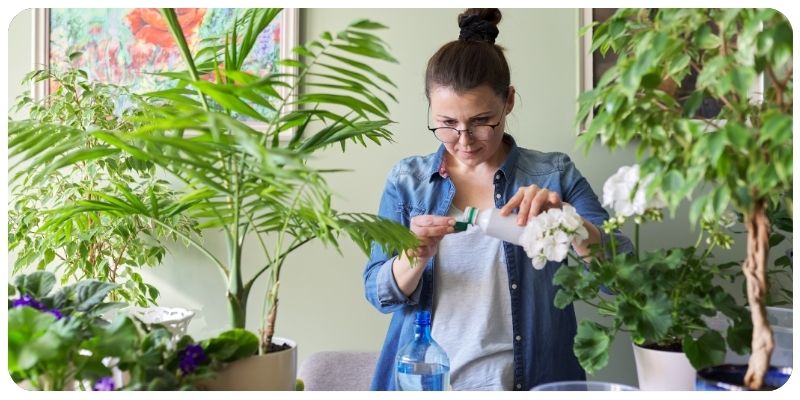
The Best Fertilizers for Indoor Plants
Fertilizing your indoor plants is essential to keep them healthy and thriving. Unlike outdoor plants that can access nutrients from the soil, indoor plants rely on you to provide them with the necessary nourishment. In this guide, we’ll explore the best fertilizers for indoor plants and how to choose the right one for your houseplants.
1. Why Fertilizers Are Important for Indoor Plants
Indoor plants are limited by the nutrients available in the potting mix, and over time, these nutrients get depleted. Fertilizers replenish essential nutrients such as nitrogen (N), phosphorus (P), and potassium (K) – the three primary nutrients plants need to grow. By using the right fertilizer, you can promote healthy foliage, flowers, and root growth.
2. Types of Fertilizers for Indoor Plants
There are several types of fertilizers you can choose from, each with its own benefits. Below are the most common types of fertilizers for indoor plants:
Liquid Fertilizers
Liquid fertilizers are one of the most popular choices for indoor plants because they’re easy to use and provide immediate nutrients to the plant. These fertilizers are diluted with water and applied during regular watering.
- Pros: Easy to control dosage, quick absorption, and can be used during the plant's active growing season.
- Cons: Needs to be applied more frequently than slow-release fertilizers.
Slow-Release Fertilizers
Slow-release fertilizers come in granules or pellets and release nutrients gradually over time. These are ideal for those who prefer a low-maintenance option.
- Pros: Long-lasting, only needs to be applied a few times per year.
- Cons: Can be harder to control the exact amount of nutrients being released.
Organic Fertilizers
Organic fertilizers are made from natural materials such as compost, manure, and bone meal. These fertilizers improve soil structure and provide nutrients slowly over time.
- Pros: Environmentally friendly, improves soil health.
- Cons: Nutrients are released more slowly, and some organic fertilizers can have a strong odor.
3. How to Choose the Right Fertilizer for Your Indoor Plants
When selecting a fertilizer, consider the type of plant, its growth stage, and its specific nutrient needs. Here’s a breakdown of what to look for when choosing a fertilizer:
Balanced Fertilizers (N-P-K Ratio)
The N-P-K ratio represents the balance of nitrogen, phosphorus, and potassium in the fertilizer. A balanced fertilizer (e.g., 10-10-10) is suitable for most houseplants, providing even nutrients for foliage, root, and flower growth.
High Nitrogen Fertilizers
If your plant has lots of foliage (e.g., ferns or peace lilies), a fertilizer with higher nitrogen content (N) will promote lush, green growth.
Phosphorus-Rich Fertilizers
Plants that flower frequently, such as orchids or African violets, benefit from fertilizers higher in phosphorus (P), which promotes blooming.
4. When and How to Fertilize Indoor Plants
Most indoor plants should be fertilized during their active growing season, typically spring and summer. Avoid fertilizing during the winter months when many houseplants are dormant. Here’s how to properly fertilize your indoor plants:
Steps to Fertilize Your Indoor Plants
- Read the Instructions: Always follow the dosage instructions on the fertilizer packaging. Over-fertilizing can harm your plants.
- Apply During Watering: For liquid fertilizers, mix the fertilizer with water according to the instructions and apply it during your regular watering routine.
- Avoid Fertilizer Burn: Be cautious of fertilizer burn, which occurs when too much fertilizer is applied. It can cause brown or crispy leaf edges.
5. Common Fertilizer Mistakes to Avoid
To ensure your indoor plants stay healthy, avoid these common fertilization mistakes:
- Over-fertilizing: Too much fertilizer can lead to nutrient buildup in the soil, causing root damage and leaf burn.
- Fertilizing During Dormancy: Fertilizing when plants are dormant can stress them and lead to poor growth.
- Using the Wrong Fertilizer: Using a fertilizer that doesn’t match your plant’s needs can stunt growth or cause other issues. Make sure to choose the right type for your specific plants.
Conclusion
Fertilizing your indoor plants with the right type and amount of fertilizer is key to keeping them healthy and vibrant. Whether you prefer liquid, slow-release, or organic fertilizers, understanding your plant’s needs will help you choose the best option. By following these tips and avoiding common mistakes, you’ll ensure your houseplants thrive all year long.